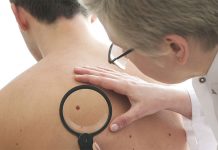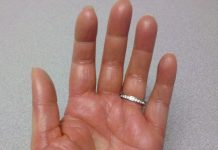Thankfully only a small minority of people with skin cancer actually die from their disease. Also thankfully, this is a kind of cancer that starts out in the outer layer of the skin and so can be easy to detect at the earlier stages.
However skin cancers or skin neoplasms as they are also known are also the most common types of cancer so it is important to be vigilant about them.
 As in the case of all cancers, early detection and swift treatment is the key to survival and recovery from skin cancer and its three main classifications (a) Basal Cell Cancer (b) Squamous Cell Cancer and (c) Melanoma.
As in the case of all cancers, early detection and swift treatment is the key to survival and recovery from skin cancer and its three main classifications (a) Basal Cell Cancer (b) Squamous Cell Cancer and (c) Melanoma.
So it is important to know the risk factors and early warning signs and later symptoms of skin cancer.
Skin cancer risk factors
- A family history of skin cancer can be predictor of the disease.
- Those with fair skin are more at risk of having skin cancer than darker skinned people.
- Those who have large moles or have more than 50 moles, big or small on their body, may be more at risk of melanoma.
- Severe sunburn early in life and a skin that is prone to burning rather than tanning is known to be a melanoma risk factor.
- Basal cell carcinoma and squamous cell carcinoma risk rises with sun exposure and people living in areas that have strong sunshine are known to be more at risk.
- Most skin cancers occur after age 50 so age is a risk factor since the cancers can occur as a result of accumulated sun damages.
- Use of tanning beds is also linked to increased skin cancer risk.
Early warning signs of skin cancer
Any changes in skin such as alteration in color, appearance of falling of the skin should be noted. Any changes in birthmarks, moles, or sores that don’t heal could also be warning signs. A bleeding sore or one that hurts and continues to itch, scab, crust and erode, should also not be ignored.
Symptoms of basal cell carcinoma
This skin cancer is the commonest but also the easiest to treat fully and without any scarring. This may start off as a sore that doesn’t heal or may appear as a bumpy, smooth feature on the neck, head or shoulders. The center of the tumor may bleed and crust and may be translucent with visible blood vessels.
Symptoms of squamous cell carcinoma
A reddening, thickening or scaling of skin in an area frequently exposed to sun may be noted. Bleeding and ulceration of the tumor is common, and it may be firm and dome shaped. While this can be a dangerous form of skin cancer and may progress into a dangerous and disfiguring large mass, it isn’t as deadly as melanoma.
Symptoms of melanoma
This cancer is the most dangerous because it can travel (metastasize) to other parts of the body and can also be fatal. This cancer presents most often in the form of black or brown, sometimes red, pink or flesh colored lesions. They often originate from moles that change in size, shape or color.














